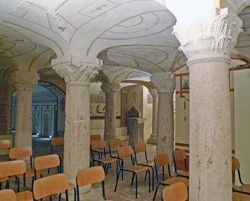
The steps in front of the presbytery lead down to the crypt of the original church. However, it is usually open to visitors from the Museo Diocesano.
According to Paola Guerrini and Francesca Latini (referenced below, at p. 129-30), what survives of the first church on this site is:
-
“... essentially, the crypt and its oratory, together with the capitals of the columns that have been reused in it and, probably, some sculptural elements [both still in the crypt, illustrated as their Figures 62 and 63]. The church, in this phase, was already in the form a nave and two aisles, separated by columns, with the presbytery raised above the crypt and terminated in an apse” (my translation).
These remains suggest that this church and its crypt were built in the 11th century.
The crypt underwent renovations in the 17th and 19th centuries.
Reliquary Chapel
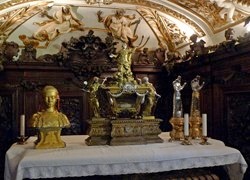
The grating (17th century) on the first landing opens onto a collection of reliquaries.
Reliquary of St Maron (1499)
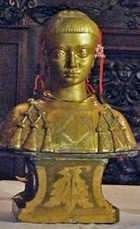
Main part of the Crypt
The crypt is still used for the graves of the bishops of Foligno.
Columns (11th century)
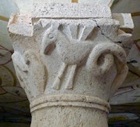
Roman Inscription (1st century AD)
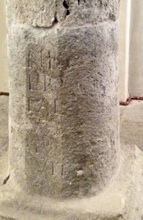

Detail
This fragmentary inscription (CIL XI 5209), which is inserted in one of the columns, reads:
VO [... et]
[Iuno]NI R[eg(inae) et]
[Min]ERV[ae et]
[dis d]EAB[usque]
[...]IUSM(arci) [f(ilius) ...]
[... Sper]ATUS [...]
[... po]SUIT [
This inscription, which commemorates Juno and Minerva (with Jove possibly included in the top line) seems to have come from a base of some sort, presumably commissioned by ‘ ... ius ... Sperlatus, son of Marcus’.
According to Luigi Sensi (referenced below, at p. 312), the inscription:
-
“... was probably executed in the 1st century AD, as seems to be indicated by the form of the letters and the type of monument. The base might have supported a donario (donative altar) or a foculum (a small hearth used for sacrifices) used in the cult of the divinities [commemorated]. We are probable dealing with a gift offered in a local sanctuary, as seems to be indicate by the use of the Apennine limestone, although we have no other data relating to its location” (my translation).
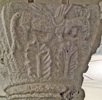
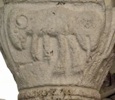
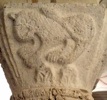
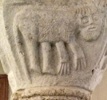
This column also has an interesting zoomorphic capital.
Early Christian Inscription (4th/ 5th century AD)
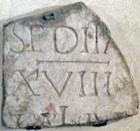
[ ....]/ sedit a[nnos]
XVIII d[epositus]
kal(endas) iu[nias? lias?]
It apparently came from the funerary monument of an early bishop who had held that post for 18 years before his death in June or July of an unknown year. According to Francesca Lanzoni (referenced below, at pp. 450-1), it related to:
-
“... a bishop of Foligno or Forum Flaminii. [Archival records at the time of its transfer to Foligno] date it to the 4th century, although other scholars who have seen it think that we must date it to the 6th century or later” (my translation).
More recent estimates have been published by:
-
✴Luigi Sensi (referenced below, at p. 315) - between the late 4th century and the early 5th century;
-
✴Gianfranco Binazzi (referenced below, at p. 102) - between the end of the 4th century and the middle of the 5th century;
-
✴Paola Guerrini and Francesca Latini (referenced below, p. 277, in entry 31) - tentatively, 4th or 5th century; and
-
✴the EDR database (see the link above) - 370 - 450 AD.
Thus, the inscription might well commemorate a predecessor of either:
-
✴Urbanus (documented in 487), the first bishop of civitas Fulginia for whom we have a name; or
-
✴Boniface (documented in 502), the first bishop of Forum Flaminii for whom we have a name.
Lid of a Sarcophagus (8th century ?)
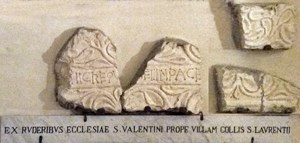
Four fragments of the lid of a sarcophagus were moved here from San Valentino di Civitavecchia in 1918. Unfortunately, the last part of the inscription is missing, so we do not know whose sarcophagus it covered. What survives of the inscription reads:
Hic requ[ies]cet in pace [...]
The form of words indicates that the deceased was a Christian and, given the find spot, we might reasonably assume that he had been buried in the cemetery of San Valentino. Luigi Sensi (referenced below, at pp. 316-7) illustrated the fragments (as Figures 7 and 8, and dated it to roughly the 8th century.
Sculptural Elements (11th century ?)
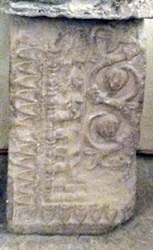


According to Paola Guerrini and Francesca Latini (referenced below, p. 291 and Figures 62 and 63), these fragments in the crypt came from the original Duomo.
Read more:
P. Guerrini and F. Latini, “Foligno: Dal Municipium Romano alla Civitas Medievale: Archeologia e Storia di una Città Umbra”, (2012) Spoleto
L. Sensi, “La Raccolta Archeologica della Cattedrale di Foligno”, Bollettino Storico della Città di Foligno, 9 (1985) 305-26
G. Binazzi, “Inscriptiones Christianae Italiae: Regio VI; Umbria”, (1989) Bari
F. Lanzoni, “Le Diocesi d' Italia dalle Origini al Principio del Secolo VII”, Faenza (1927)
Return to the Main page on the Duomo.
Proceed to the Cella di San Pietro Crisci.



